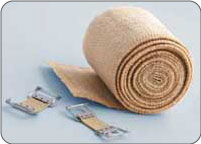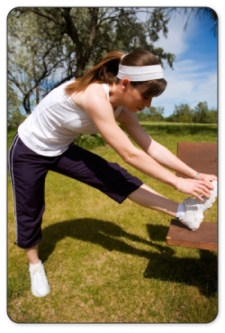Maintaining flexible and strong hamstring muscles and tendons is the first step to preventing injury. Below you will find some tips on how to achieve healthier hamstrings.
Wear appropriate athletic and/or regular shoes that are comfortable and provide significant arch support and motion control.

Utilize corrective footwear, orthotics or other foot devices provide support and alignment (check to see if you wear out the soles of your shoes on one side) and/or supportive items, such as compression shorts, braces or taping to eliminate stress on your muscles.
Modify, decrease and/or avoid activities or motions that cause pain and irritation, and ensure you always warm up and cool down before participating in activities.
Gentle massage after vigorous activities will help relax your tissues; PT, acupressure, deep massage and chiropractic care are also good for more severe cases.

Proper food and fluid intake prior to and during activities will ensure you are nourished and prevent against fatigue and dehydration.
Weight loss and/or weight maintenance involves eating a balanced diet full of protein, complex carbohydrates, fats, vitamins, minerals, phytochemicals and antioxidants which will help support a healthy system. If you gain just 10 pounds, your joints must bear from 25 up to 100 pounds extra, which can add unnecessary stress to your body. Limiting your caffeine, alcohol and nicotine consumption will also improve your health.
Follow a stretching, strengthening, and endurance exercise routine that conditions your hamstrings, as well as your other leg muscles, lower back, gluteals and pelvis which will keep your muscles balanced, strong and limber.
If you are suffering from hamstring tendon pain, listen to your body and decrease, modify and/or avoid any activities or motions that cause pain and irritation (quick stopping/starting, turning, running or jumping, as well as participating on uneven terrain). If you are required to perform these motions at work or play and cannot avoid them, make sure you take frequent breaks and rest to prevent fatigue and pain.

Before beginning exercise or training, ask your doctor or physical therapist for a list of appropriate exercises that will not cause further harm to your weak hamstrings while you work to strengthen them.
To stabilize your hamstring and leg area, and increase your range of motion, maintain and build your strength, stability and flexibility of your hamstring, leg, gluteal, pelvis, low back and core body muscles. Light weights, exercise bands and balls are very beneficial for strengthening your lower body. Core balance training and plyometrics (exercises to develop strength, speed and agility, such as jumping or bounding movements) are also an excellent addition to your exercise routine. Yoga, tai chi, or a daily stretching routine will help to keep your muscles and joints supple (avoid sudden twisting and turning motions).
A regular exercise program that focuses on total body fitness and includes low-impact aerobic activity at least 3 days per week, such as walking, swimming or biking will help to keep you healthy overall and will strengthen your body to prevent against further hamstring injuries.
Hamstring injuries are frustrating to live with and healing can take a long time because it's difficult to give your leg the rest it needs. This is especially true for runners and other athletes that return to their sport too early. Re-injury is common but it prolongs recovery and may also lead to permanent damage and other conditions.
Treating your hamstring tendon injury correctly is essential to getting rid of your pain and restoring function to your upper thigh, hip and knee. Proper treatment will get you back to regular activities sooner, stop your pain, and reduce the risk of future re-injury.
Learn more about Hamstring Tendon Treatments.
AidYourHamstring advisors do not work on commission, so be assured you will only receive fair and objective information.
Product Advisors are available 9:00 am to 5:00 pm Eastern Standard Time Monday to Friday.
I want to learn more about Surgery & Post-Surgery Recovery
I want to learn more about Circulation Boost
I want to learn more about Ice & Heat: Which Is Better For Treatment?
I want to learn more about Stretching for the Hamstring
I want to learn more about Soft Tissue Injury Treatments
During your recovery, you will probably have to modify and/or eliminate any activities that cause pain or discomfort at the location of your soft tissue injury until the pain and inflammation settle. The more diligent you are with your treatment and rehabilitation, the faster you will see successful results!
Please be aware that this information is neither intended nor implied to be a substitute for professional medical advice. CALL YOUR HEALTHCARE PROVIDER IMMEDIATELY IF YOU THINK YOU MAY HAVE A MEDICAL EMERGENCY. Always seek the advice of your physician or other qualified health provider before using any of our outstanding products to make sure they are right for you and your condition or if you have any questions regarding a medical condition. Always see your doctor for a proper diagnosis as there are often many injuries and conditions (some very serious) that could be the cause of your pain.
© 2025 In.Genu Design Group, Inc. Contact Us